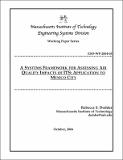| dc.description.abstract | Intelligent Transportation Systems (ITS)—the application of communications and information technology to surface transportation systems—has the potential to improve transportation along several dimensions, from safety to emissions reductions to travel time and reliability. ITS has become a worldwide technology, and many cities in Latin America are currently deploying ITS, from individual technologies to entire ITS Architectures. While improving mobility is at the core of any ITS deployment, in metropolitan areas from Mexico City to Sao Paulo, air quality concerns are such that ignoring possible air quality impacts of ITS technologies represents either a failure to leverage ITS for air quality improvements, or even a risk of running counter to air quality management efforts. While there is a growing number of studies evaluating the air quality benefits of ITS, there are important limitations on the extent to which the results of these studies can be used to support planning of ITS in cities in Latin America. First, the challenges involved in modeling ITS air quality benefits mean that they typically focus on only one or two ITS technologies at a time. Second, air quality and mobility conditions vary greatly across cities, meaning that air quality outcomes will also vary widely. Finally, from a planning standpoint, a more system-wide and qualitative framework is needed to generate the kind of dialogue needed between a diverse number of groups—environmental, transportation, public works, public security, and transport operators—to decide how ITS can meet a metropolitan area needs. In order to address these issues, I develop a systems framework that can encompass a number of ITS technologies and performance measures. Within this systems framework, I look specifically at air quality. Rather than focusing on particular modeling tools, I break down air quality impacts into eight mechanisms that can lead to decreases or increases in mobile source emissions. I will also return briefly to the literature on ITS environmental benefits, to review which mechanisms are included as variables. Finally, I will consider the case of Mexico City, and the interactions between current ITS deployments and air quality. | en_US |
